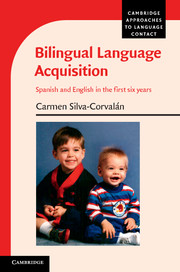Book contents
- Frontmatter
- Dedication
- Contents
- List of figures
- List of tables
- Series editor’s foreword
- Preface
- Acknowledgments
- List of abbreviations
- 1 Introduction
- 2 Methodology
- 3 Bilingual development
- 4 Subjects in English and Spanish
- 5 The order of constituents: subject position in English and Spanish
- 6 The acquisition of ser, estar, and be
- 7 The development of verb morphology
- 8 Discussion and conclusions
- Appendix 1 Transcription instructions
- Appendix 2 Calculation of MLUw
- Appendix 3 Spanish adjectives used with copulas up to age 6;0
- Appendix 4 The siblings’ early verb lexicon in English and Spanish
- Appendix 5 Excerpt from an adapted Goldilocks story
- References
- Index of authors
- General index
2 - Methodology
Published online by Cambridge University Press: 18 December 2014
- Frontmatter
- Dedication
- Contents
- List of figures
- List of tables
- Series editor’s foreword
- Preface
- Acknowledgments
- List of abbreviations
- 1 Introduction
- 2 Methodology
- 3 Bilingual development
- 4 Subjects in English and Spanish
- 5 The order of constituents: subject position in English and Spanish
- 6 The acquisition of ser, estar, and be
- 7 The development of verb morphology
- 8 Discussion and conclusions
- Appendix 1 Transcription instructions
- Appendix 2 Calculation of MLUw
- Appendix 3 Spanish adjectives used with copulas up to age 6;0
- Appendix 4 The siblings’ early verb lexicon in English and Spanish
- Appendix 5 Excerpt from an adapted Goldilocks story
- References
- Index of authors
- General index
Summary
Introduction
Bilingual infants and children are ideal subjects for cross-language acquisition research, but not all about them is perfect. Indeed, cognitive and socioeconomic conditions are under control in the comparison of the languages, but the ecology of each language is frequently different (Mufwene 2001) and patterns of use quite variable. This brings about the development of unequal levels of proficiency in the languages involved and results in paths of acquisition not strictly comparable on an equal footing. Furthermore, research has found much interindividual variation, similar to that exhibited by monolingual children, a situation that is especially problematic in cases where only one language is the majority language or enjoys the status of being official. Generalizations based on the outcomes of case studies need to be made with caution, therefore, because children’s acquisition of each language depends upon their sociolinguistic history in each language and these histories can be different even within the same family. Some children grow up speaking two languages fluently, while others attain a reduced form of one of the languages, and others understand the less-used language but do not acquire productive proficiency at all.
Ecological differences result in the possibility of developing higher or lower levels of bilingual proficiency. This raises the question of how much exposure children need in order to gain a productive command of a construction. Some have argued that a critical mass of input data has to be accumulated for a child to generalize beyond stored instances of language constructions; this has also been suggested for bilinguals (Silva-Corvalán 2003a). But the question of what constitutes “a critical mass” in BFLA is virtually unexplored. This book gives information about the siblings’ global amount of exposure to each of their languages, from which some answer to the issue of the critical mass may be gleaned, but the specific amount of input needed to learn a particular structure is beyond the scope of the present study.
- Type
- Chapter
- Information
- Bilingual Language AcquisitionSpanish and English in the First Six Years, pp. 27 - 53Publisher: Cambridge University PressPrint publication year: 2014



